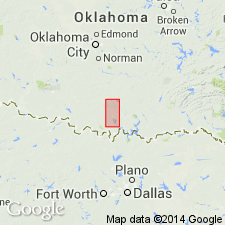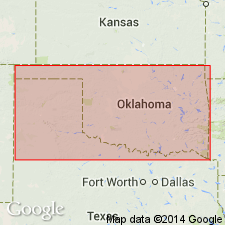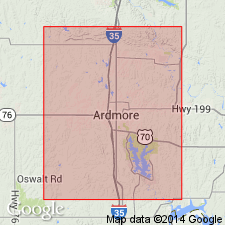
- Usage in publication:
-
- Hoxbar member
- Modifications:
-
- Named
- Dominant lithology:
-
- Limestone
- Sandstone
- Shale
- AAPG geologic province:
-
- South Oklahoma folded belt
Summary:
Named as uppermost member of five of the Glenn formation; probably named for town of Hoxbar, Carter Co, OK, S. Oklahoma folded belt province. No type locality given. Occurs southeast of Ardmore and west of Hoxbar. Basal part consists of several brown limestones, one of which is prolific FUSILINA CYLINDRICA horizon. Upper part consists of white sandstones separated by light-blue to yellow and red shales. Becomes less calcareous toward the southeast. Near top of member, 4 mi southeast of Ardmore, a coal seam 2-4 ft thick occurs. Total thickness of Hoxbar is 4,000 ft. Overlies Deese member (new) of Glenn formation. Underlies undesignated Carboniferous redbeds. Geologic map; structural map; cross sections; vertical sections. According to correlation table, correlates with Canyon formation in north-central TX and with (descending order) Holdenville shale, Wewoka formation, Wetumka shale, and Calvin sandstone in OK north of Arbuckle Mountains. Fossils (brachiopods, mollusks) listed. Of Pennsylvanian age.
Source: GNU records (USGS DDS-6; Denver GNULEX).

- Usage in publication:
-
- Hoxbar member
Summary:
Glenn formation as mapped on Oklahoma geologic map corresponds to Glenn formation of Goldston [1922], except that his Springer member north of Ardmore is included in Caney shale. His Springer member around Criner Hills south of Ardmore is held by G.H. Girty and P.V. Roundy to be younger than the Springer north of Ardmore, and is mapped as part of Glenn.
Source: US geologic names lexicon (USGS Bull. 896, p. 988).

- Usage in publication:
-
- Hoxbar formation
- Modifications:
-
- Revised
- AAPG geologic province:
-
- South Oklahoma folded belt
Summary:
Raised in rank to formation. Was formerly included as uppermost member (of 5) of the Glenn formation (Goldston, 1922). Is seen in the Ardmore basin in southern OK in the S. Oklahoma folded belt province. Type area given in secs 26 and 35, T5S, R2E, Carter Co, OK, where it includes about 4000 ft of strata. Divided into the following members (ascending): Confederate limestone, Union Dairy, Westheimer, Crinerville, Anadarche, Daube, and Zuckermann. These members separated from each other by unnamed parts of Hoxbar. The only coal known in Ardmore basin is 4 ft thick; extends 4 mi along strike in T5S, R2E; occurs just below Daube. Consists chiefly of shales, including much brownish, yellow, and reddish shale as well as usual bluish to tan variety. Is the youngest formation exposed beneath the Pontotoc series in the Ardmore basin; overlies the Deese formation (raised in rank). Fossils: fusulinids, brachiopods, mollusks, etc. Geologic maps; columnar section. Of Pennsylvanian age.
Source: GNU records (USGS DDS-6; Denver GNULEX).
For more information, please contact Nancy Stamm, Geologic Names Committee Secretary.
Asterisk (*) indicates published by U.S. Geological Survey authors.
"No current usage" (†) implies that a name has been abandoned or has fallen into disuse. Former usage and, if known, replacement name given in parentheses ( ).
Slash (/) indicates name conflicts with nomenclatural guidelines (CSN, 1933; ACSN, 1961, 1970; NACSN, 1983, 2005, 2021). May be explained within brackets ([ ]).

